Opening and Post-Rift Evolution of Alpine Tethys Passive Margins: Insights from 1D Numerical Modeling of the Jurassic Mikulov Formation in the Vienna Basin Region, Austria
Abstract
:1. Introduction
2. Regional Geological Outline
2.1. Autochthonous Mesozoic Unit
2.2. Allochthonous Unit with Thrust Complex
2.3. Miocene Basin System
3. Approach, Methodology, and Construction of 1D Pseudo Models
- Gresten Fm.: The autochthonous Middle Jurassic sediments were deposited in an extensional basin ([17] and references therein), overlying the crystalline basement of the Bohemian massif and Permian sedimentary rocks on the southern edge of the European plate (Figure 2b). Deposited in rifting half-graben structures, the paleowater level experienced significant variations [10,32,46,47,48], leading to the formation of four main subunits (Figure 3); (i) the Lower Quartzarenite Member (Mbr.) comprises fluvial deltaic sandstone, shale, and coal. Locally, the sand layers contain rift-related volcanic rocks. (ii) The marine prodelta shale was deposited as the Lower Shale Mbr. during ongoing rifting and subsequent sea level rise. Similarly, (iii) the Upper Quartzarenite Mbr. consists of deltaic sandstone with shale layers akin to those in the Lower Mbr. (iv) The uppermost subunit, the Upper Shale Mbr., exhibits a similar composition to the Lower Shale Mbr. and was deposited in the Callovian age during ongoing subsidence. Its younger layers have undergone erosion.
- Höflein Fm. and Vranovich Fm.: Marking the conclusion of the syn-rifting phase, the early post-rift sediments unconformably overlay the Gresten Fm., which were deposited in unstable to stable marine environments [19,46]. The Höflein Fm. (Callovian) comprises dolomitic sandstones. By the Oxfordian age, a uniform carbonate deposition system (Vranovice/Vranovich Fm.), characterized by passive margin dolostones and limestones devoid of clastic input, was established.
- Klentnitz Group: The depositional environment underwent differentiation based on variations in basin depth and sedimentation type. In the western parts of the basin, a carbonate ramp formed, where shallow-water carbonates, known as the Altenmarkt Fm., were deposited. The eastern basin parts transitioned into a deeper marine environment, leading to the deposition of the transitional facies of the Falkenstein Fm. and the basinal marlstone of the Mikulov Fm. [14,46]. The transitional zone between the shallow- and deep-water environments represents a slope environment. These three formations constitute the Upper Jurassic Klentnitz Group. The Mikulov and Falkenstein strata are significant source rocks for organic matter, contributing to oil and thermogenic (thermocatalytic) gas generation [13,14]. In the study area, the Mikulov Fm. reaches a thickness up to 1.5 km (Figure 6a). The thickness of the Mikulov layer was tested in several scenarios: 400 m, 1300 m, and 700 m (Table S1). The thickness values were estimated based on data from drilling and seismic profiles reaching the Alpine Tethys-related autochthonous units in the Zistersdorf–Maustrenk area (e.g., [13,19,23]). These thicknesses represent locations on the passive margin stage or vary as a function of the thickness itself. The variations in the thickness of the Mikulov package align with the subsectors of a passive margin, reflecting changes in the depositional setting relative to water depth. The thinnest value represents a shallower depositional environment, while the thickest value represents areas surrounding the depocenter. The Klentnitz Group is discordantly overlain by the sandy dolomitic limestone of the Kurdejov Fm., which transitioned into the oldest Cretaceous limestone(?) of the Ernstbrunn Fm. (Barriasian) (Figure 3). Subsequently, significant regression and erosion affected the strata.
- Ameis Fm. and Poysdorf Fm.: Sedimentation during the Late Cretaceous period led to the deposition of the Ameis Fm., comprising sand and marlstone, and the Poysdorf Fm., comprising shale and marlstone [46]. According to [17], the Upper Jurassic carbonates and marls are overlain by glauconitic Upper Cretaceous sandstone, with thicknesses reaching up to 900 m [73].
- Waschberg Zone: The Waschberg deformation event, spanning the Paleocene to Oligocene, contributed to the interruption and subsequent formation of the Molasse Basin and other geological structures (e.g., [12]).
- Quaternary: The Quaternary deposits have a max. thickness of 50 m.
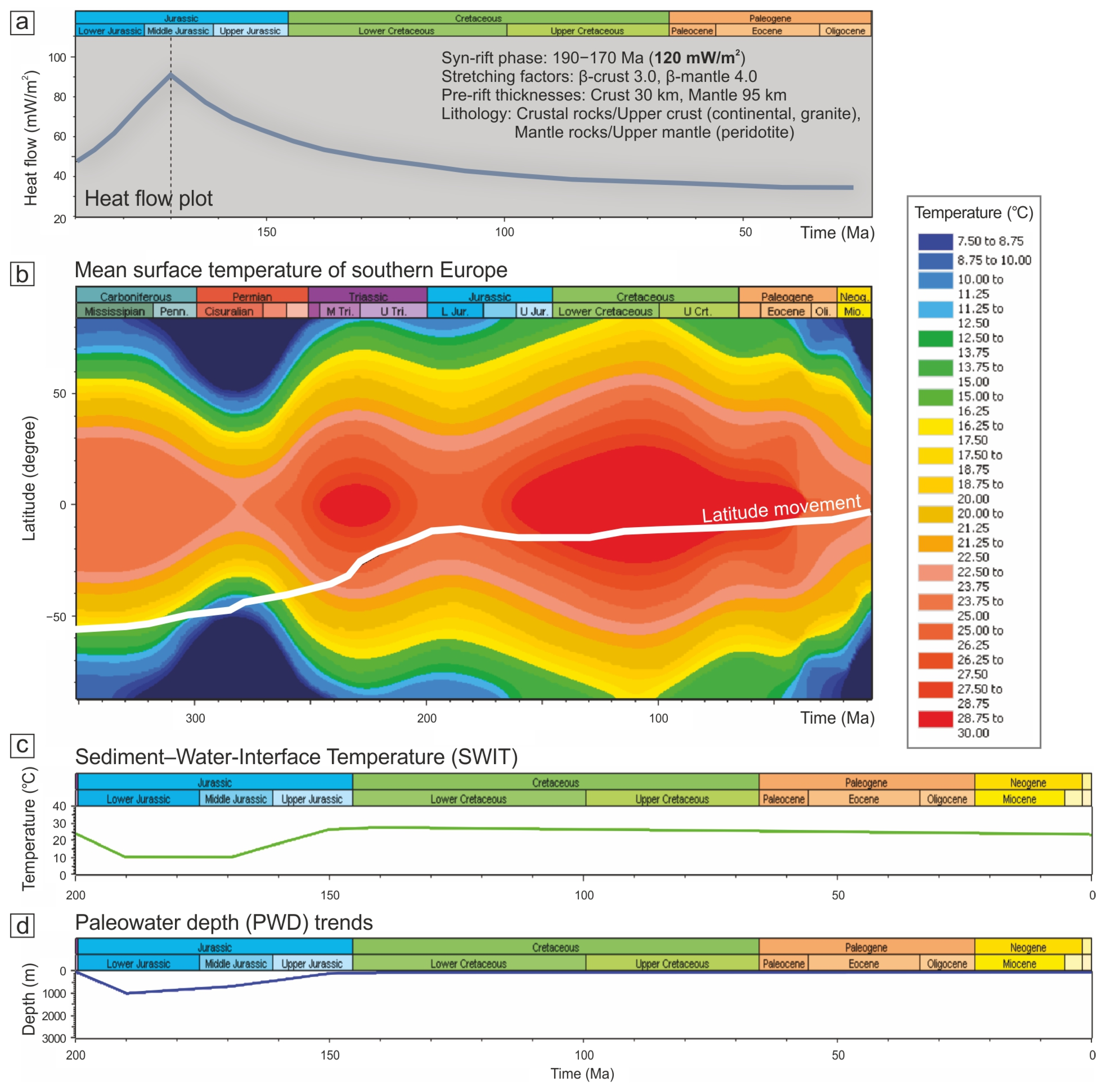
4. Results
- Computed sedimentation rates during the syn-rift stage averaged around 200 m/Ma (Figure 8), which is lower compared to peri-Pannonian Neogene basins (e.g., [67]). For the Mikulov Fm., these rates were evaluated across different thicknesses as the primary input, characterizing shallow, moderate, and deeper depositional settings of the Upper Jurassic Alpine Tethys. With a present-day thickness of 400 m, the sedimentation rate was approximately 48 m/Ma, significantly slower than during the syn-rift phase, particularly in the Upper Quartzite Mbr. interval (Figure 8a). For a thickness of 1300 m, the sedimentation rate increased to approximately 120 m/Ma (Figure 8b). An intermediate thickness of 700 m resulted in a sedimentation rate of around 43 m/Ma. These findings illustrate the variability in sedimentation rates relative to different depositional settings and thickness inputs, providing a framework for understanding the subsidence history over time;
- The overlapping time diagrams exhibit extracted data from the Mikulov Fm. for the time frame spanning from the Jurassic to the present day (Figure 9). Among a number of computed parameters, we focused on parameters such as maximum effective stress, layer thickness over time, sedimentation rate, and EASY%Ro of the Mikulov Fm. (e.g., [76]). The results indicate that the maximum effective stress increases immediately once the sedimentation ceases and compaction begins due to overburden accumulation. The sedimentation rates during the Upper Jurassic varies among the models, which were approximately 46 m/Ma, 150 m/Ma, and 80 m/Ma, respectively (Figure 9). The initial layer thicknesses for the same time slice ranged from 280 to 690 m. These data show relatively low thermal maturation at the onset of subsequent subsidence, highlighting the impact of compaction and sedimentation rates on the thermal history of the formation;
- The computed time-depth models spanning the Lower Jurassic to the Eocene revealed significant differences between the syn-rift and post-rift stages. The models are (Figure 10) (a) computed subsurface heat flow distribution with PWD, (b) computed heat flow with sedimentation rate and subsidence depths, and (c) computed thermal maturity according to EASY%Ro. The numerical output data provide constraints on both the syn-rift formations (notably, the Upper Shale Mbr.) and the post-rift formations (notably, the Mikulov Fm.). The input heat flow values show a significant decline after the typical syn-rift phase with 120 mW/m2, reflected in the computed time-based EASY%Ro values (Figure 9). The thermal point-based maturation time plot (Figure 10) was given by applying the EASY%Ro equation (e.g., [76]). The thermal maturity data align with the calibration data, suggesting that the oil window is between 4000 and 6000 m (extending further in depth).
5. Discussion
5.1. Crustal Mechanisms and Oceanic Opening
5.2. Mikulov Fm.: Tracing the Early Evolution of the Alpine Tethys Passive Margin
5.3. Implication of Extensional Detachment
6. Conclusions
- The mechanism of the Alpine Tethys opening during the syn-rift stage could not be solely driven by rift-related crustal stretching. Alternatively, crustal subsidence might be associated with a “cold” lithospheric-scale downwelling;
- By integrating 1D numerical modeling with a modified kinematic model and a geodynamic background, this study provides realistic inputs for quantifying the presumed Alpine Tethys rifting stages, particularly for the post-rift Mikulov Fm.;
- The computed subsidence rates delineated the syn-rift and post-rift stages, with subsidence rates gradually decelerating during the post-rift stage, consistent with general models. The consistency in sedimentation rates from syn- to post-rift stages, including a subsequent Lower Cretaceous hiatus (uplift), suggests excellent indicators marking the regional extension of the Alpine Tethys;
- The sedimentation pattern computed for the Mikulov Fm. reflects typical passive margin development related to slow thermal subsidence, which ended after the Jurassic period. This latest Jurassic stage can be correlated with similar latest Jurassic convergence stages observed across the regions, including the Carpathian–Balkans;
- The combined results from the 1D numerical modeling, including compaction trends and hydrocarbon expulsion, offer insights into the reactivation and formation of extensional tectonic detachment, such as listric faults and subsequent Neogene tectonic subsidence;
- The best-fit scenario depicts the Mikulov Fm. with a thickness of approximately 1300 m near the deepest basin depocenter. It indicates favorable but lower-grade maturity conditions, contrasting with models featuring shallower Jurassic depositional domains. The lower maturity is likely the marker of an atypical subsidence mechanism, driven by a “cold” lithospheric-scale downwelling.
Supplementary Materials
Author Contributions
Funding
Data Availability Statement
Acknowledgments
Conflicts of Interest
Appendix A
| No. | Well | Depth [m] | TOC [%] | S1 [mgHC/g] | S2 [mgHC/g] | Tmax [C] | HI [mgHC/gTOC] | S [%] | TOC/S |
|---|---|---|---|---|---|---|---|---|---|
| 1 | Zistersdorf ÜT 1 | 5602.7 | 2.77 | 2.42 | 4.33 | 448 | 156 | 0.84 | 3.29 |
| 2 | Zistersdorf ÜT 1 | 5605.5 | 1.18 | 0.94 | 1.50 | 449 | 126 | 0.49 | 2.40 |
| 3 | Zistersdorf ÜT 1 | 5670.5 | 2.66 | 1.93 | 3.41 | 452 | 128 | 0.55 | 4.80 |
| 4 | Zistersdorf ÜT 1 | 5674.6 | 2.80 | 2.03 | 4.16 | 451 | 149 | 0.50 | 5.60 |
| 5 | Zistersdorf ÜT 1 | 5737.3 | 1.93 | 1.64 | 2.74 | 454 | 142 | 0.06 | 31.29 |
| 6 | Zistersdorf ÜT 1 | 5740.7 | 1.76 | 1.88 | 2.49 | 453 | 141 | 0.24 | 7.42 |
| 7 | Zistersdorf ÜT 1 | 5977.3 | 3.05 | 2.59 | 3.54 | 456 | 116 | 0.53 | 5.74 |
| 8 | Zistersdorf ÜT 1 | 5983.7 | 3.33 | 1.11 | 2.85 | 461 | 85 | 0.79 | 4.22 |
| 9 | Zistersdorf ÜT 2a | 7704 | 2.73 | n.d. | n.d. | n.d. | n.c. | 0.63 | 4.36 |
| 10 | Zistersdorf ÜT 2a | 8153 | 0.72 | n.d. | n.d. | n.d. | n.c. | 0.35 | 2.06 |
| 11 | Zistersdorf ÜT 2a | 8544 | 0.74 | n.d. | n.d. | n.d. | n.c. | 0.44 | 1.68 |
| 12 | Zistersdorf ÜT 2a | 5586 | 2.04 | 2.67 | 3.45 | 450 | 169 | 0.22 | 9.16 |
| 13 | Zistersdorf ÜT 2a | 5587 | 2.16 | 2.40 | 2.90 | 446 | 134 | 1.14 | 1.90 |
Appendix B
| Compiled Thermal Maturity | ||
|---|---|---|
| VR vs. Depth | VR | TR |
| Mikulov Formation was drilled at a depth range of 1400–8551 m | ||
| 4000 m | 0.8% | |
| 4800 m | 1.0% | 0.75 |
| 5000 m | 1.2% | |
| 5500 m | 1.5% | |
| 6000 m | 1.8% | |
| 6600 m | 2.1% | |
| 8500 m | 2.2% | |
| To provide an additional maturity overview, all wells with depth penetrating the Mikulov Fm. are provided | ||
| Aderklaa UT 1a, 6076.5 m | 1.8% | |
| Ameis 1, ~3000 m | <0.8% | |
| Falkenstein 1, 3300–3900 m | <0.8% | |
| Fallbach 1, ~1800 m | <0.8% | |
| Hofflein 7a, ~2700 m | <0.8% | |
| Klement 1, 2400 m | <0.8% | |
| Korneuburg T1, 3200 m | <0.8% | |
| Maustrenk ÜT 1a, 6500 m | ca.2.0% | |
| Merkersdorf 2, 1900 m | <0.8% | |
| Roseldorf T1, 1300 m | <0.8% | |
| Staatz 1, 1900–2800 m | <0.8% | |
| Stronegg 1, 2000 m | <0.8% | |
| Thomasl 1, 2300–3000 m | <0.8% | |
| Wildendürnbach T1, 1500 m | <0.8% | |
| Zistersdorf ÜT 1, 5600–5900 m | 1.5–1.7% | |
| Zistersdorf ÜT 2a, 5500–8500 m | 1.5–2.2% | |
| In the Czech part of the Vienna Basin, the following wells penetrated the Mikulov Fm. at the interval from 2500 to 4500 m:Kobylí 1, Morkůvky 1, Němčičky 1, Němčičky 4, Němčičky 5, Nové Mlýny 1, Nové Mlýny 2, Nové Mlýny 3, Sedlec 1, Kobylí 1, Bulhary 1, Ježov 2, Uhřice 18, Uhřice 19 | <0.8% | |
| Gresten Fm | 0.5–0.6% | |
References
- Froitzheim, N.; Eberli, G.P. Extensional detachment faulting in the evolution of a Tethys passive continental margin, Eastern Alps, Switzerland. Geol. Soc. Am. Bull. 1990, 102, 1297–1308. [Google Scholar] [CrossRef]
- Mandl, G.W. The Alpine sector of the Tethyan shelf–Examples of Triassic to Jurassic sedimentation and deformation from the Northern Calcareous Alps. Mitt. Österr. Mineral. Ges. 2000, 92, 61–77. [Google Scholar]
- Stampfli, G.M. Tethyan oceans. Geol. Soc. Spec. Publ. 2000, 173, 1–23. [Google Scholar] [CrossRef]
- Lemoine, M.; Bas, T.; Arnaud-Vanneau, A.; Arnaud, H.; Dumont, T.; Gidon, M.; Tricart, P. The continental margin of the Mesozoic Tethys in the Western Alps. Mar. Pet. Geol. 1986, 3, 179–199. [Google Scholar] [CrossRef]
- Bernoulli, D.; Jenkyns, H.C. Ancient oceans and continental margins of the Alpine-Mediterranean Tethys: Deciphering clues from Mesozoic pelagic sediments and ophiolites. Sedimentology 2009, 56, 149–190. [Google Scholar] [CrossRef]
- Zhao, Z.; Sun, Z.; Qiu, N.; Zhao, M.; Zhang, J.; Li, F.; Lin, J.; Lee, E.Y. The paleo-lithospheric structure and rifting-magmatic processes of the northern South China Sea passive margin. Gondwana Res. 2023, 120, 162–174. [Google Scholar] [CrossRef]
- Fries, G.; Parize, O. Anatomy of ancient passive margin slope systems: Aptian gravity-driven deposition on the Vocontian palaeomargin, western Alps, south-east France. Sedimentology 2003, 50, 1231–1270. [Google Scholar] [CrossRef]
- Tari, G.; Strauss, P. The Jurassic Gresten facies of the European margin in Austria, Hungary and Romania: A regional overview. Berichte Der Geol. Bundesanst. 2018, 128, 154. [Google Scholar]
- Decker, K. Miocene tectonics at the Alpine-Carpathian junction and the evolution of the Vienna Basin. Mitt. Ges. Geol. Bergbaustud. Österr. 1996, 41, 33–44. [Google Scholar]
- Wessely, G. Sedimente des Wiener Beckens und seiner alpinen und subalpinen Unterlagerung (The Vienna Basin and its alpine and subalpine basement). Mitt. Ges. Geol. Bergbaustud. Österr. 2000, 44, 191–214. [Google Scholar]
- Lee, E.Y.; Wagreich, M. Polyphase tectonic subsidence evolution of the Vienna Basin inferred from quantitative subsidence analysis of the northern and central parts. Int. J. Earth Sci. 2017, 106, 687–705. [Google Scholar] [CrossRef]
- Beidinger, A.; Decker, K. Quantifying Early Miocene in-sequence and out-of-sequence thrusting at the Alpine-Carpathian junction. Tectonics 2014, 33, 222–252. [Google Scholar] [CrossRef]
- Rupprecht, B.J.; Sachsenhofer, R.F.; Gawlick, H.J.; Kallanxhi, M.E.; Kucher, F. Jurassic source rocks in the Vienna basin (Austria): Assessment of conventional and unconventional petroleum potential. Mar. Pet. Geol. 2017, 86, 1327–1356. [Google Scholar] [CrossRef]
- Schicker, A.; Gier, S.; Schieber, J.; Krois, P. Diagenesis of the Malmian Mikulov Formation source rock, Vienna Basin: Focus on matrix and pores. Mar. Pet. Geol. 2021, 129, 105082. [Google Scholar] [CrossRef]
- Blížkovský, M.; Kocak, A.; Morkovsky, M.; Novotny, A.; Gaza, B.; Kostelnicek, P.; Muller, P. Exploration history, geology, and hydrocarbon potential in the Czech Republic and Slovakia. In Hydrocarbons of Eastern Central Europe: Habitat, Exploration and Production History; Popescu, B.M., Ed.; Springer: Berlin/Heidelberg, Germany, 1994; pp. 71–117. ISBN 978-3-642-77207-8. [Google Scholar] [CrossRef]
- Krézsek, C.; Adam, J.; Grujic, D. Mechanics of fault and expulsion rollover systems developed on passive margins detached on salt: Insights from analogue modelling and optical strain monitoring. Geol. Soc. Spec. Publ. 2007, 292, 103–121. [Google Scholar] [CrossRef]
- Ladwein, H.W. Organic geochemistry of Vienna basin: Model for hydrocarbon generation in overthrust belts. AAPG Bull. 1988, 72, 586–599. [Google Scholar] [CrossRef]
- Ciprys, V.; Adámek, J.; Benada, S. Petroleum geology of the Carpathian Foredeep and overthrust zones in the Czech Republic. Petrol. Geosci. 1995, 1, 89–95. [Google Scholar] [CrossRef]
- Picha, F.J.; Zdenek, S.; Oldrich, K. Geology and hydrocarbon resources of the Outer Western Carpathians and their foreland, Czech Republic. In AAPG Memoir: The Carpathians and Their Foreland: Geology and Hydrocarbon Resources; Golonka, J., Picha, F.J., Eds.; American Association of Petroleum Geologists: Tulsa, OK, USA, 2006; Volume 84, pp. 49–175. [Google Scholar] [CrossRef]
- Picha, F.J.; Peters, K.E. Biomarker oil-to-source rock correlation in the Western Carpathians and their foreland, Czech Republic. Petrol. Geosci. 1998, 4, 289–302. [Google Scholar] [CrossRef]
- Scotese, C.R. PALEOMAP PaleoAtlas for GPlates and the PaleoData Plotter Program. In Paleomap Project. 2016. Available online: www.earthbyte.org/paleomap-paleoatlas-for-gplates (accessed on 16 February 2023).
- Wessely, G. Der Untergrund des Wiener Beckens. In Erdöl und Erdgas in Österreich; Brix, F., Schultz, O., Eds.; Naturhistorisches Museum und F.Berger: Horn, Austria, 1993; pp. 249–280. ISBN 3-900312-88-5. [Google Scholar]
- Wessely, G. Geological results of deep exploration in the Vienna basin. Geol. Rundsch. 1990, 79, 513–520. [Google Scholar] [CrossRef]
- Francu, J.; Bohacek, Z.; Radke, M.; Schaefer, R.G.; Poelchau, H.S.; Caslavsky, J. Oil-oil and oil-source rock correlations in the northern Vienna basin and adjacent Carpathian Flysch zone (Czech and Slovak area). In Oil and Gas in Alpidic Thrustbelt and Basins of Central and Eastern Europe; Wessely, G., Liebl, W., Eds.; EAGE Special Publication 5; Geological Society: London, UK, 1996; pp. 343–353. [Google Scholar]
- Arzmüller, G.; Buchta, S.; Ralbovský, E.; Wessely, G. The Vienna basin. In AAPG Memoir 84: The Carpathians and Their Foreland: Geology and Hydrocarbon Resources; Golonka, J., Picha, F.J., Eds.; American Association of Petroleum Geologists: Tulsa, OK, USA, 2006; pp. 191–204. [Google Scholar]
- Lee, E.Y.; Wagreich, M. 3D visualization of the sedimentary fill and subsidence evolution in the northern and central Vienna Basin (Miocene). Austrian J. Earth Sci. 2016, 109, 241–251. [Google Scholar] [CrossRef]
- Adamek, J. The Jurassic floor of the Bohemian Massif in Moravia–geology and paleogeography. Bull. Geosci. 2005, 80, 291–305. [Google Scholar]
- Ślączka, A.; Gasiński, M.; Bąk, M.; Wessely, G. The clasts of Cretaceous marls in the conglomerates of the Konradsheim Formation (Pöchlau quarry, Gresten Klippen Zone, Austria). Geol. Carpath. 2009, 60, 151–164. [Google Scholar] [CrossRef]
- Petri, B.; Wijbrans, J.R.; Mohn, G.; Manatschal, G.; Beltrando, M. Thermal evolution of Permian post-orogenic extension and Jurassic rifting recorded in the Austroalpine basement (SE Switzerland, N Italy). Lithos 2023, 444–445, 107124. [Google Scholar] [CrossRef]
- Gier, S. Clay mineral and organic diagenesis of the Lower Oligocene Schöneck Fishshale, western Austrian Molasse basin. Clay Miner. 2000, 35, 709–717. [Google Scholar] [CrossRef]
- Hamilton, W.; Wagner, L.; Wessely, G. Oil and gas in Austria. Mitt. Österr. Geol. Ges. 2000, 92, 235–262. [Google Scholar]
- Sachsenhofer, R.F.; Bechtel, A.; Kuffner, T.; Rainer, T.; Gratzer, R.; Sauer, R.; Sperl, H. Depositional environment and source potential of Jurassic coal-bearing sediments (Gresten Formation, Hoflein gas/condensate field, Austria). Petrol. Geosci. 2006, 12, 99–114. [Google Scholar] [CrossRef]
- Gusterhuber, J.; Hinsch, R.; Sachsenhofer, R.F. Evaluation of hydrocarbon generation and migration in the Molasse fold and thrust belt (Central Eastern Alps, Austria) using structural and thermal basin models. AAPG Bull. 2014, 98, 253–277. [Google Scholar] [CrossRef]
- Frank, W.; Schlager, W. Jurassic strike-slip versus subduction in the Eastern Alps. Int. J. Earth. Sci. 2006, 95, 431–450. [Google Scholar] [CrossRef]
- Lukeneder, A.; Halasova, E.; Kroh, A.; Mayrhofer, S.; Pruner, P.; Rehakova, D.; Wagreich, M. High-resolution stratigraphy of the Jurassic-Cretaceous boundary interval in the Gresten Klippenbelt (Austria). Geol. Carpath. 2010, 61, 365–381. [Google Scholar] [CrossRef]
- Artyushkov, E.V.; Baer, M.A. Mechanism of continental crust subsidence in the Alpine Belt. Tectonophysics 1984, 108, 193–228. [Google Scholar] [CrossRef]
- Bertotti, G. Subsidence, deformation, thermal and mechanical evolution of the Mesozoic South Alpine rifted margin: An analogue for Atlantic-type margins. Geol. Soc. Spec. Publ. 2001, 187, 125–141. [Google Scholar] [CrossRef]
- Strauss, P.; Granado, P.; Muñoz, J.A. Subsidence analysis of salt tectonics-driven carbonate minibasins (Northern Calcareous Alps, Austria). Basin Res. 2020, 33, 968–990. [Google Scholar] [CrossRef]
- McKenzie, D. Some remarks on the development of sedimentary basins. Earth Planet. Sci. Lett. 1978, 40, 25–32. [Google Scholar] [CrossRef]
- Stampfli, G.M.; Borel, G.D.; Marchant, R.; Mosar, J. Western Alps geological constraints on western Tethyan reconstructions. J. Virtual Explor. 2002, 8, 77–106. [Google Scholar] [CrossRef]
- Faupl, P.; Wagreich, M. Late Jurassic to Eocene palaeogeography and geodynamic evolution of the Eastern Alps. Mitt. Österr. Geol. Ges. 2000, 92, 79–94. [Google Scholar]
- Harzhauser, M.; Daxner-Höck, G.; Piller, W.E. An integrated stratigraphy of the Pannonian (Late Miocene) in the Vienna Basin. Aust. J. Earth Sci. 2004; 95/96, 6–19. [Google Scholar]
- Harzhauser, M.; Kranner, M.; Mandic, O.; Strauss, P.; Siedl, W.; Piller, W.E. Miocene lithostratigraphy of the northern and central Vienna Basin (Austria). Aust. J. Earth Sci. 2020, 113, 169–200. [Google Scholar] [CrossRef]
- Seifert, P. Palinspastic reconstruction of the easternmost Alps between upper Eocene and Miocene. Geol. Carpath. 1992, 43, 327–331. [Google Scholar]
- Strauss, P.; Harzhauser, M.; Hinsch, R.; Wagreich, M. Sequence stratigraphy in a classic pull-apart basin (Neogene, Vienna Basin). A 3D seismic based integrated approach. Geol. Carpath. 2006, 57, 185–197. [Google Scholar]
- Wessely, G. Geologie der Österreichischen Bundesländer: Niederösterreich; Geologische Bundesanstalt: Wien, Austria, 2006. [Google Scholar]
- Brix, F.; Kröll, A.; Wessely, G. Die Molasse zone und deren Untergrund in Niederösterreich. Erdöl-Erdgas-Z. Sonderausg. 1977, 93, 12–35. [Google Scholar]
- Eliáš, M. Paläogeographische Entwicklung des Mesozoikums und des Tertiärs am Rande der Karpaten und des Böhmischen Massifs. Erdöl-Erdgas-Z. Sonderausg. 1977, 93, 5–11. [Google Scholar]
- Steiner, T.M.C.; Gawlick, H.J.; Melcher, F.; Schlagintweit, F. Ophiolite derived material as parent rocks for Late Jurassic bauxite: Evidence for Tithonian unroofing in the Northern Calcareous Alps (Eastern Alps, Austria). Int. J. Earth Sci. 2021, 110, 1847–1862. [Google Scholar] [CrossRef]
- Spahić, D.; Kurešević, L.; Cvetković, Ž. Constraints on the Late Cretaceous post-Neotethyan oblique convergence, the olistolith perspective (Sava Suture Zone, segment Ripanj-Ropočevo-Kosmaj Mt., Belgrade area, Serbia). Carbonate Evaporite 2023, 38, 51. [Google Scholar] [CrossRef]
- Spahić, D.; Barjaktarović, M.; Mukherjee, S.; Bojić, Z. Tithonian limestone as a marker of early contraction of NeoTethyan Vardar Ocean: Structural constraints on the latest Jurassic—Earliest Cretaceous “docking” (Dobroljupci, Kuršumlija, Jastrebac Mt., Serbia). Carbonate Evaporite, 2024; in press. [Google Scholar]
- Rögl, F.; Kroh, A.; Hofmann, T.; Zuschin, M. Exkursion Waschbergzone. In Österreichische Paläontologische Gesellschaft—15. Jahrestagung, Ber. Geol. BA; Zuschin, M., Hofmann, T., Eds.; Geologische Bundesanstalt: Wien, Austria, 2009; Volume 81, pp. 32–49. [Google Scholar]
- Schmid, M.S.; Bernoulli, D.; Fügenschuh, B.; Matenco, L.; Schefer, S.; Schuster, R.; Tischler, M.; Ustaszewski, K. The Alps-Carpathians-Dinarides-connection: A correlation of tectonic units. Swiss J. Geosci. 2008, 101, 139–183. [Google Scholar] [CrossRef]
- Schmid, M.S.; Fügenschuh, B.; Kounov, A.; Matenco, L.; Nievergelte, P.; Oberhänsli, R.; Pleugerg, J.; Schefer, S.; Schuster, R.; Tomljenović, B.; et al. Tectonic units of the Alpine collision zone between Eastern Alps and western Turkey. Gondwana Res. 2020, 78, 308–374. [Google Scholar] [CrossRef]
- Tari, G.; Bada, G.; Beindinger, A.; Csizmeg, J.; Danišik, M.; Gjerazi, I.; Grasemann, B.; Kovaáč, M.; Plašienka, D.; Šujan, M.; et al. The connection between the Alps and the Carpathians beneath the Pannonian Basin: Selective reactivation of Alpine nappe contacts during Miocene extension. Glob. Planet. Chang. 2021, 197, 103401. [Google Scholar] [CrossRef]
- Genser, J.; Cloetingh, S.A.; Neubauer, F. Late orogenic rebound and oblique Alpine convergence: New constraints from subsidence analysis of the Austrian Molasse basin. Glob. Planet. Chang. 2007, 58, 214–223. [Google Scholar] [CrossRef]
- Wessely, G.; Liebl, W. Oil and Gas in Alpidic Thrustbelts and Basins of Central and Eastern Europe; Geological Society: London, UK, 1996; p. 448. ISBN 1-897799-73-X. [Google Scholar]
- Knierzinger, W.; Wagreich, M.; Palzer-Khomenko, M.; Gier, S.; Meszar, M.; Lee, E.Y.; Strauss, P. Provenance and palaeogeographic evolution of Lower Miocene sediments in the eastern North Alpine Foreland Basin. Swiss J. Geosci. 2019, 112, 269–286. [Google Scholar] [CrossRef]
- Lee, E.Y.; Wagreich, M. Basin modelling with a MATLAB-based program, BasinVis 2.0: A case study on the southern Vienna Basin, Austria. J. Geol. Soc. Korea 2018, 54, 615–630. [Google Scholar] [CrossRef]
- Salcher, B.C.; Meurers, B.; Smit, J.; Decker, K.; Hölzel, M.; Wagreich, M. Strike-slip tectonics and Quaternary basin formation along the Vienna Basin fault system inferred from Bouguer gravity derivatives. Tectonics 2012, 31, TC3004. [Google Scholar] [CrossRef]
- Allen, P.A.; Allen, J.R. Basin Analysis: Principles and Application to Petroleum Play Assessment, 3rd ed.; Wiley-Blackwell: Chichester, UK, 2013; p. 640. ISBN 978-0-470-67377-5. [Google Scholar]
- Lee, E.Y.; Novotny, J.; Wagreich, M. Subsidence Analysis and Visualization: For Sedimentary Basin Analysis and Modelling; Springer: Heidelberg/Berlin, Germany, 2019; p. 56. [Google Scholar] [CrossRef]
- Hantschel, T.; Kauerauf, A.I. Fundamentals of Basin and Petroleum Systems Modeling: Integrated Exploration Systems GmbH; Schlumberger Company: Houston, TX, USA; Springer: Heidelberg/Berlin, Germany, 2009; p. 476. [Google Scholar] [CrossRef]
- Welte, D.H.; Horsfield, B.; Baker, D.R. Petroleum and Basin Evolution: Insights from Petroleum Geochemistry, Geology and Basin Modeling; Springer Science & Business Media: Berlin, Germany, 2012; p. 535. [Google Scholar] [CrossRef]
- Spahić, D.; Vanin, V.; Perepelina, A.; Aryakbaeva, Z. Normal faulting and role of the reverse drag in analyzing petroleum systems, an example of 2D modeling from the Nam Con Son Basin (Vietnam). In Proceedings of the SPE Annual Caspian Technical Conference and Exhibition, Astana, Kazakhstan, 12–14 November 2014; p. SPE-172310. [Google Scholar]
- Spahić, D.; Rundić, L. Multi-phased normal faulting of the Eisenstadt-Sopron basin margins as a controlling factor over spatially confined coal mini-hydrocarbon play (east Austria). Carpathian J. Earth Environ. Sci. 2015, 10, 45–58. [Google Scholar]
- Spahić, D.; Šajnović, A.; Burazer, N.; Radisavljević, M.; Jovančićević, B. Neogene subsidence rates of the southern Peri Pannonian realm (1D basin modeling): Constraints on the extensional geodynamic drivers of the asymmetric Toplica basin (central-southern Serbia). Geoenergy Sci. Eng. 2023, 226, 211714. [Google Scholar] [CrossRef]
- Zare-Reisabadi, M.; Kamali, M.R.; Mohammadnia, M.; Shabani, F. Estimation of true formation temperature from well logs for basin modeling in the Persian Gulf. J. Petrol. Sci. Eng. 2015, 125, 13–22. [Google Scholar] [CrossRef]
- Abdelmaksoud, A.; Ali, M.Y.; Al Suwaidi, A.; Koyi, H. Petroleum system of the fold-and-thrust belt of the United Arab Emirates: New insights based on 1D and 2D basin modeling. Mar. Petrol. Geol. 2023, 158, 106567. [Google Scholar] [CrossRef]
- Lee, E.Y.; Novotny, J.; Wagreich, M. Compaction trend estimation and applications to sedimentary basin reconstruction (BasinVis 2.0). Appl. Comput. Geosci. 2020, 5, 100015. [Google Scholar] [CrossRef]
- Cohen, K.M.; Finney, S.C.; Gibbard, P.L.; Fan, J.-X. The ICS International Chronostratigraphic Chart. Episodes 2013, 36, 199–204. [Google Scholar] [CrossRef] [PubMed]
- McKenzie, A.S.; Mckenzie, D.P. Isomerization and aromatization of hydrocarbons in sedimentary basins formed by extension. Geol. Mag. 1983, 120, 417–470. [Google Scholar] [CrossRef]
- Wagner, L.R. Tectono-stratigraphy and hydrocarbons in the Molasse Foredeep of Salzburg, Upper and Lower Austria. Geol. Soc. Spec. Publ. 1998, 134, 339–369. [Google Scholar] [CrossRef]
- Haq, B.U. Jurassic sea-level variations: A reappraisal. GSA Today 2018, 28, 4–10. [Google Scholar] [CrossRef]
- Wygrala, B.P. Integrated Study of an Oil Field in the Southern Po Basin, Northern Italy; Forschungs zentrum Jülich: Jülich, Germany, 1989; p. 2313. [Google Scholar]
- Sweeney, J.J.; Burnham, A.K. Evaluation of a simple model of vitrinite reflectance based on chemical kinetics. AAPG Bull. 1990, 74, 1559–1570. [Google Scholar] [CrossRef]
- Winterer, E.L.; Bosellini, A. Subsidence and sedimentation on Jurassic passive continental margin, Southern Alps, Italy. AAPG Bull. 1981, 65, 394–421. [Google Scholar] [CrossRef]
- Bradley, D.C. Passive margins through Earth’s history. Earth-Sci. Rev. 2008, 91, 1–26. [Google Scholar] [CrossRef]
- Golonka, J.; Krobicki, M. Upwelling regime in the Carpathian Tethys: A Jurassic-Cretaceous palaeogeographic and paleoclimatic perspective. Geol. Q. 2001, 45, 15–32. [Google Scholar]
- Tari, G.; Ciudin, D.; Kostner, A.; Raileanu, A.; Tulucan, A.; Vacarescu, G.; Vangelov, D. Play types of the Moesian Platform of Romania and Bulgaria. In Proceedings of the Exploration in the Black Sea and Caspian Regions. American Association of Petroleum Geologists, Regional Annual Conference, Kiev, Ukraine, 18 October 2010; Available online: https://www.searchanddiscovery.com/documents/2011/10311tari/ndx_tari.pdf (accessed on 1 June 2024).
- Speranza, F.; Minelli, L.; Pignatelli, A.; Gilardi, M. Curie temperature depths in the Alps and the Po Plain (northern Italy): Comparison with heat flow and seismic tomography data. J. Geodyn. 2016, 98, 19–30. [Google Scholar] [CrossRef]
- Yamada, Y.; McClay, K. Application of geometric models to inverted listric fault systems in sandbox experiments. Paper 1: 2D hanging wall deformation and section restoration. J. Struct. Geol. 2003, 25, 1551–1560. [Google Scholar] [CrossRef]
- Spahić, D.; Exner, U.; Behm, M.; Grasemann, B.; Haring, A.; Pretsch, H. Listric versus planar normal fault geometry: An example from the Eisenstadt-Sopron Basin (E Austria). Int. J. Earth Sci. 2011, 100, 1685–1695. [Google Scholar] [CrossRef]
- Sanchis, E.; Séranne, M. Structural style and tectonic evolution of a polyphase extensional basin of the Gulf of Lion passive margin: The Tertiary Alès basin, southern France. Tectonophysics 2000, 322, 219–242. [Google Scholar] [CrossRef]
- Alsop, G.I.; Weinberger, R.; Marco, S.; Levi, T. Detachment fold duplexes within gravity-driven fold and thrust systems. J. Struct. Geol. 2021, 142, 104207. [Google Scholar] [CrossRef]
- Morley, C.K.; Naghadeh, D.H. Tectonic compaction shortening in the toe region of an isolated listric normal fault, North Taranaki Basin, New Zealand. Basin Res. 2018, 30, 424–436. [Google Scholar] [CrossRef]
- Bols, H.M.; Hermanrud, C.; Teige, G.M. Origin of overpressures in shales: Constraints from basin modeling. AAPG Bull. 2004, 88, 193–211. [Google Scholar] [CrossRef]
- Zanella, A.; Cobbold, P.R.; de Veslud, C.L.C. Physical modelling of chemical compaction, overpressure development, hydraulic fracturing and thrust detachments in organic-rich source rock. Mar. Petrol. Geol. 2014, 55, 262–274. [Google Scholar] [CrossRef]
- Kopf, A. Permeability variation across an active low-angle detachment fault, western Woodlark Basin (ODP Leg 180), and its implication for fault activation. Geol. Soc. Spec. Publ. 2001, 186, 23–41. [Google Scholar] [CrossRef]
- Xu, S.; Hao, F.; Xu, C.; Wang, Y.; Zou, H.; Gong, C. Differential compaction faults and their implications for fluid expulsion in the northern Bozhong Subbasin, Bohai Bay Basin, China. Mar. Petrol. Geol. 2015, 63, 1–16. [Google Scholar] [CrossRef]
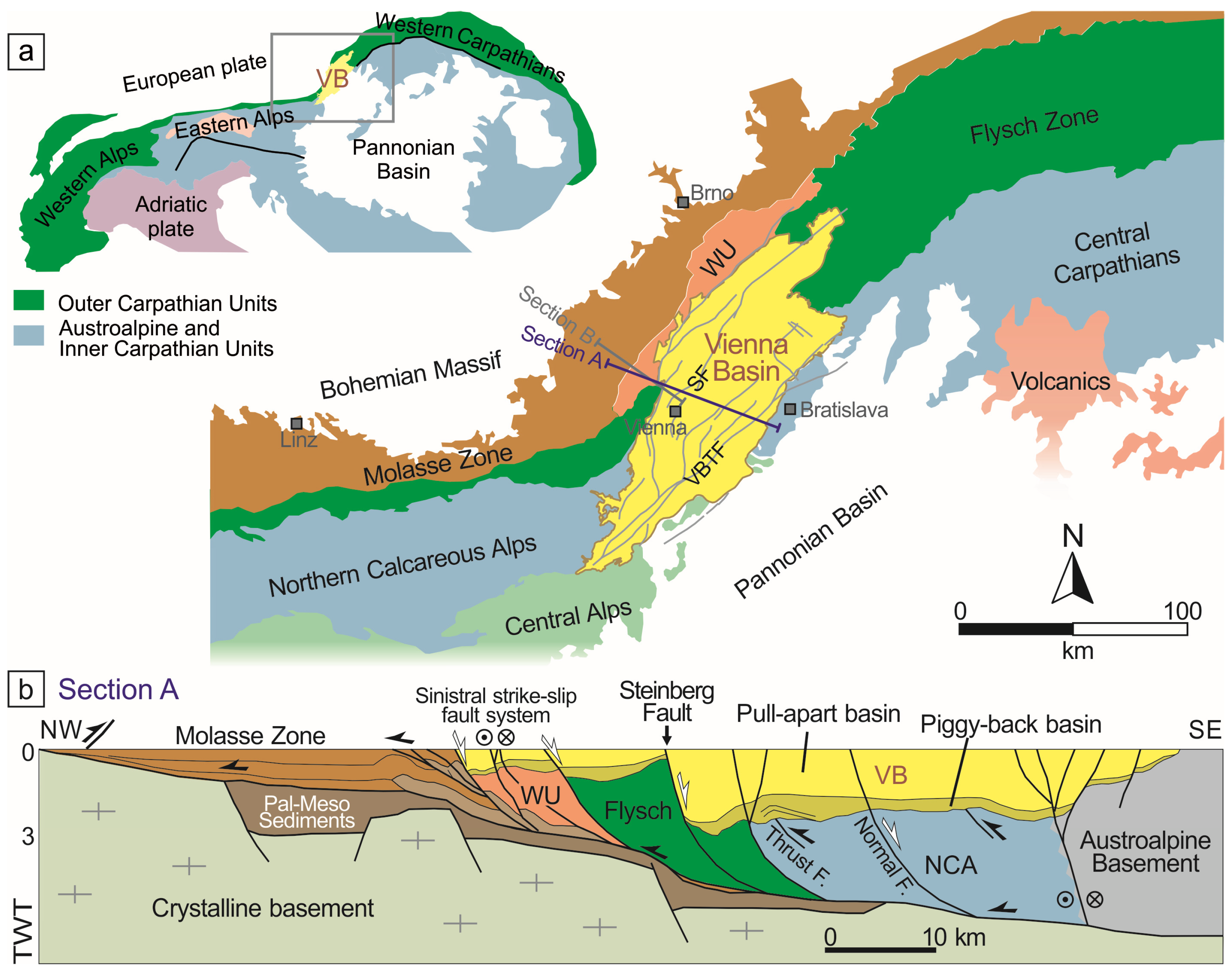
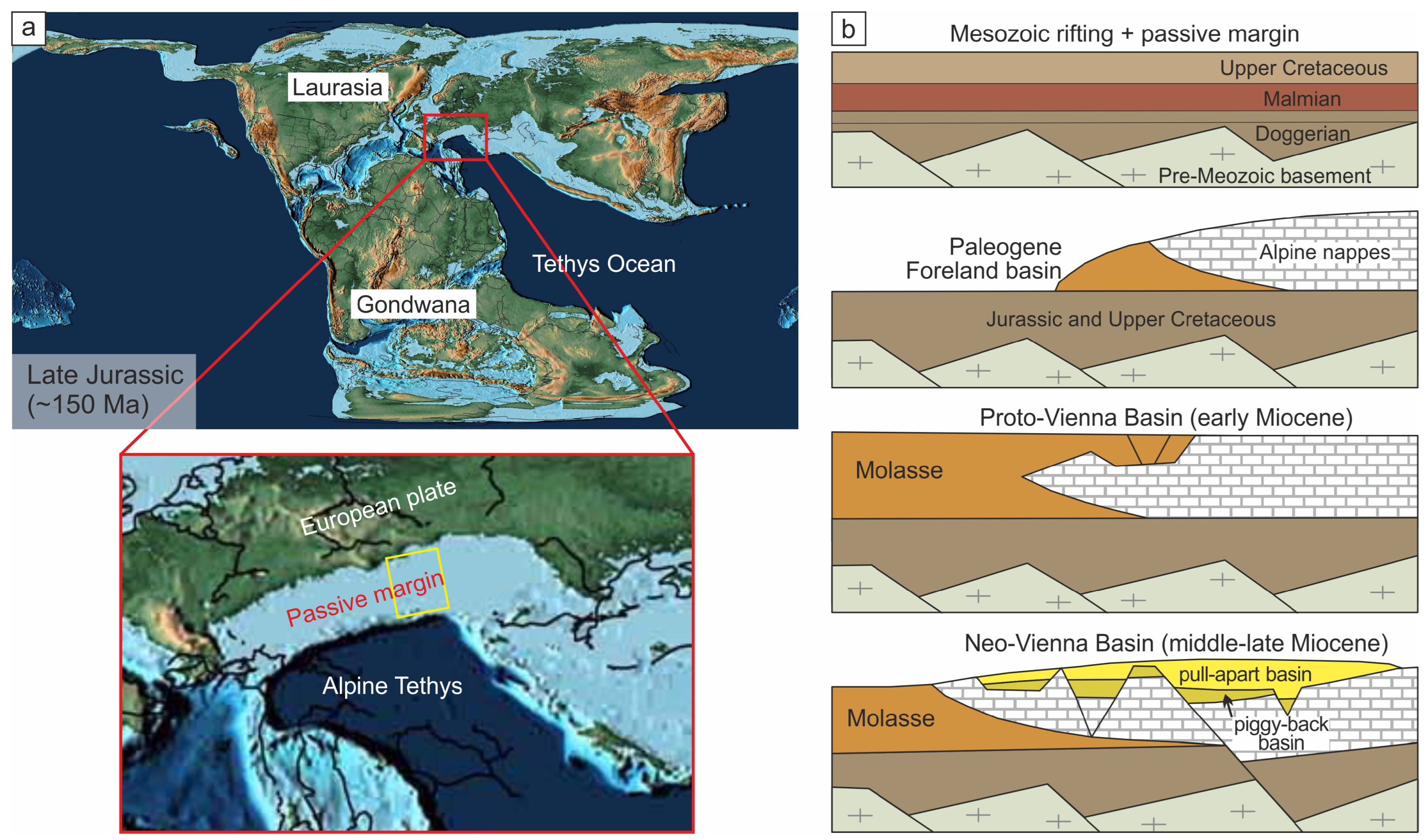

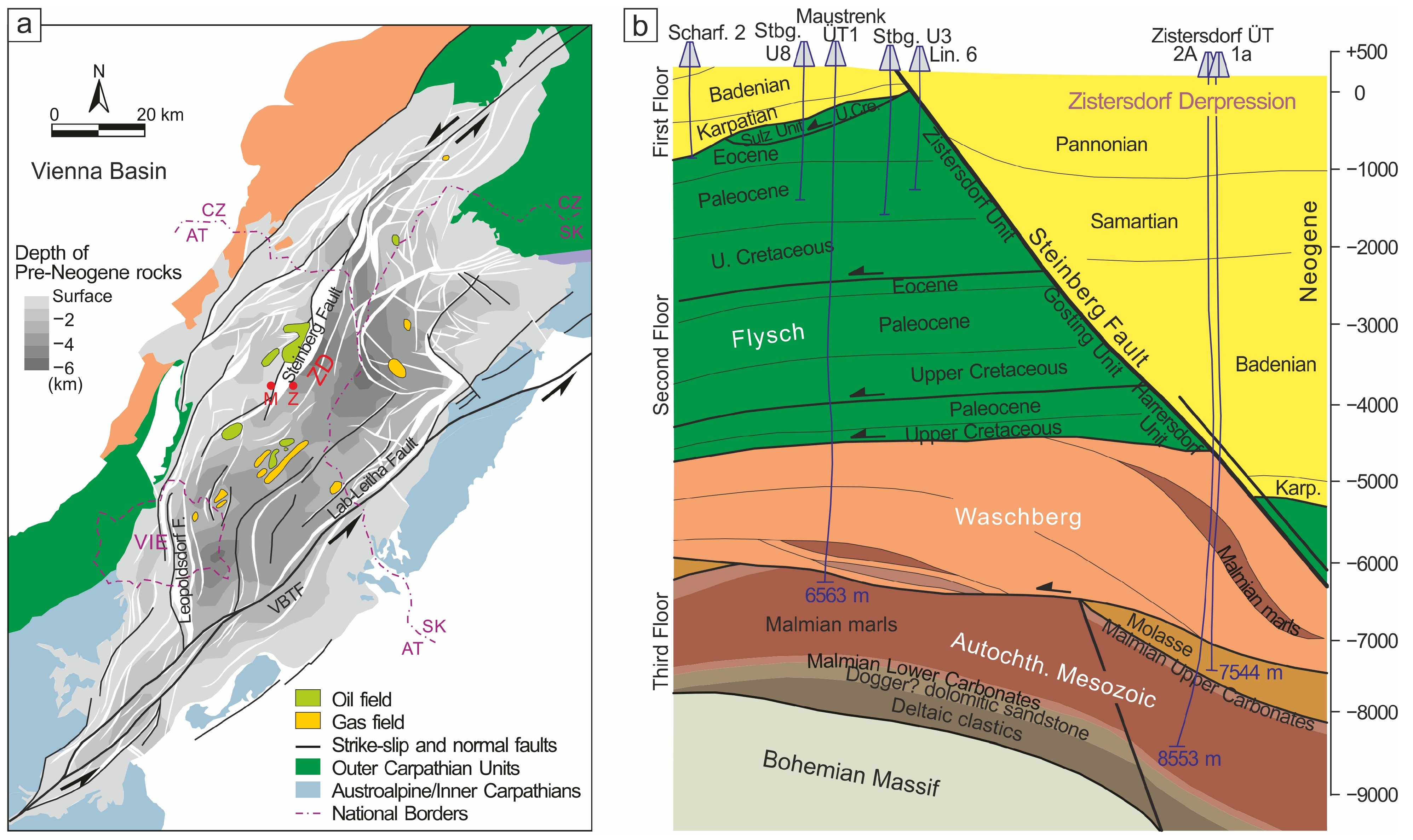
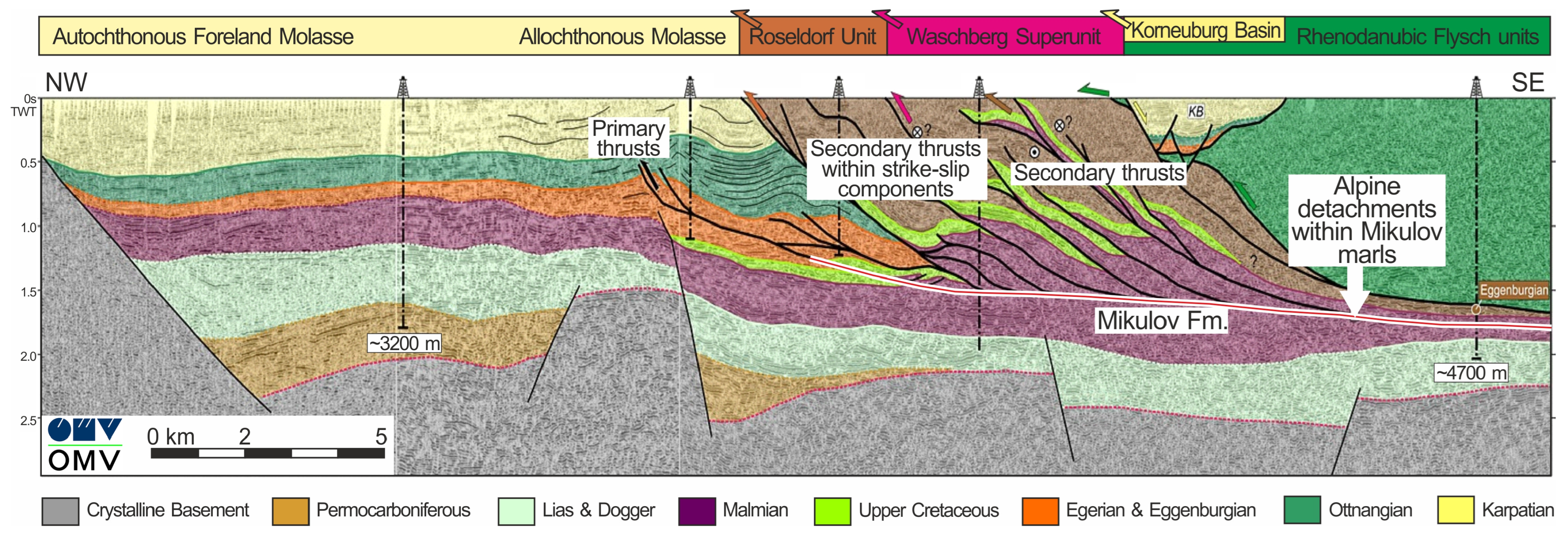


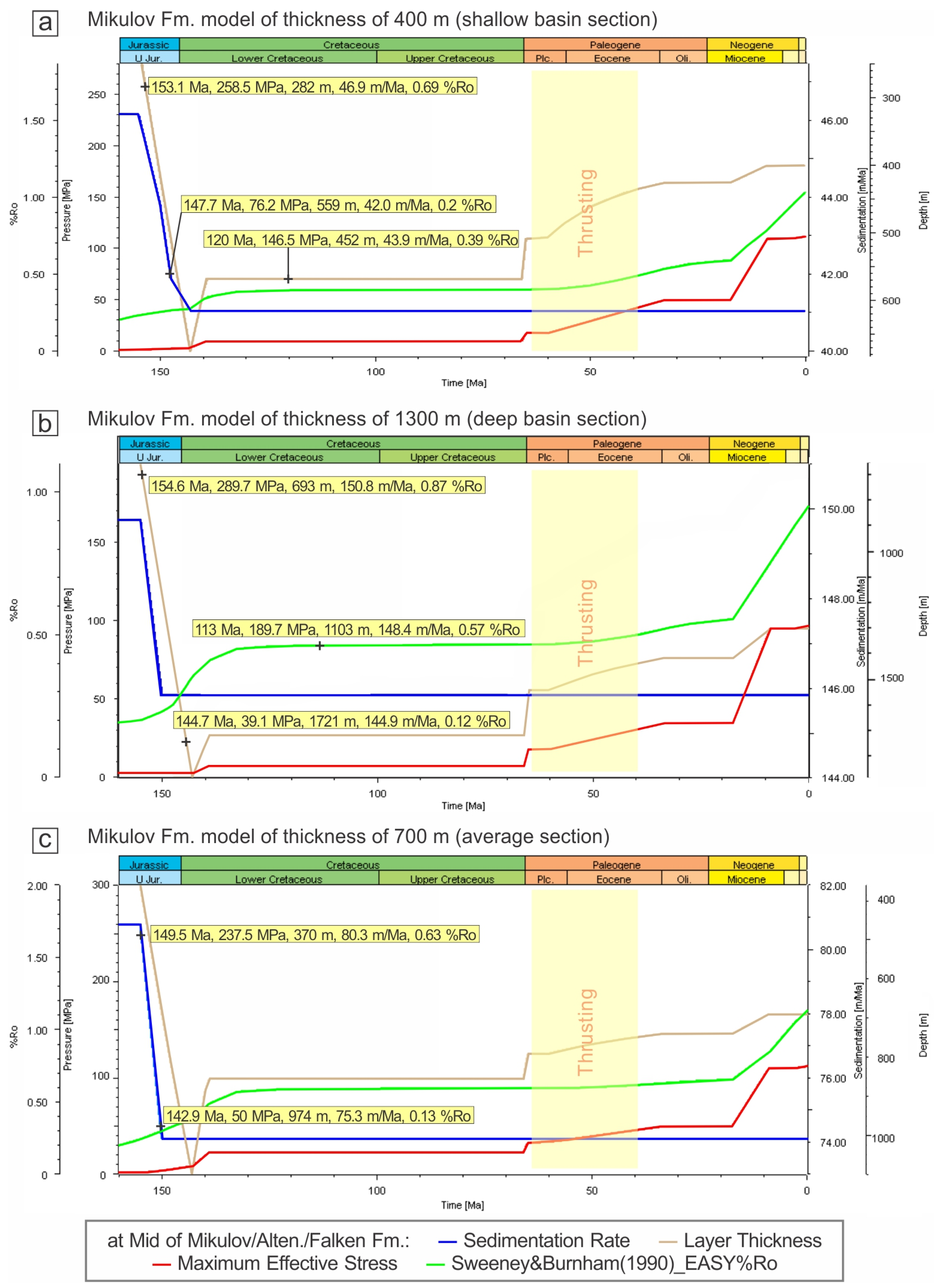

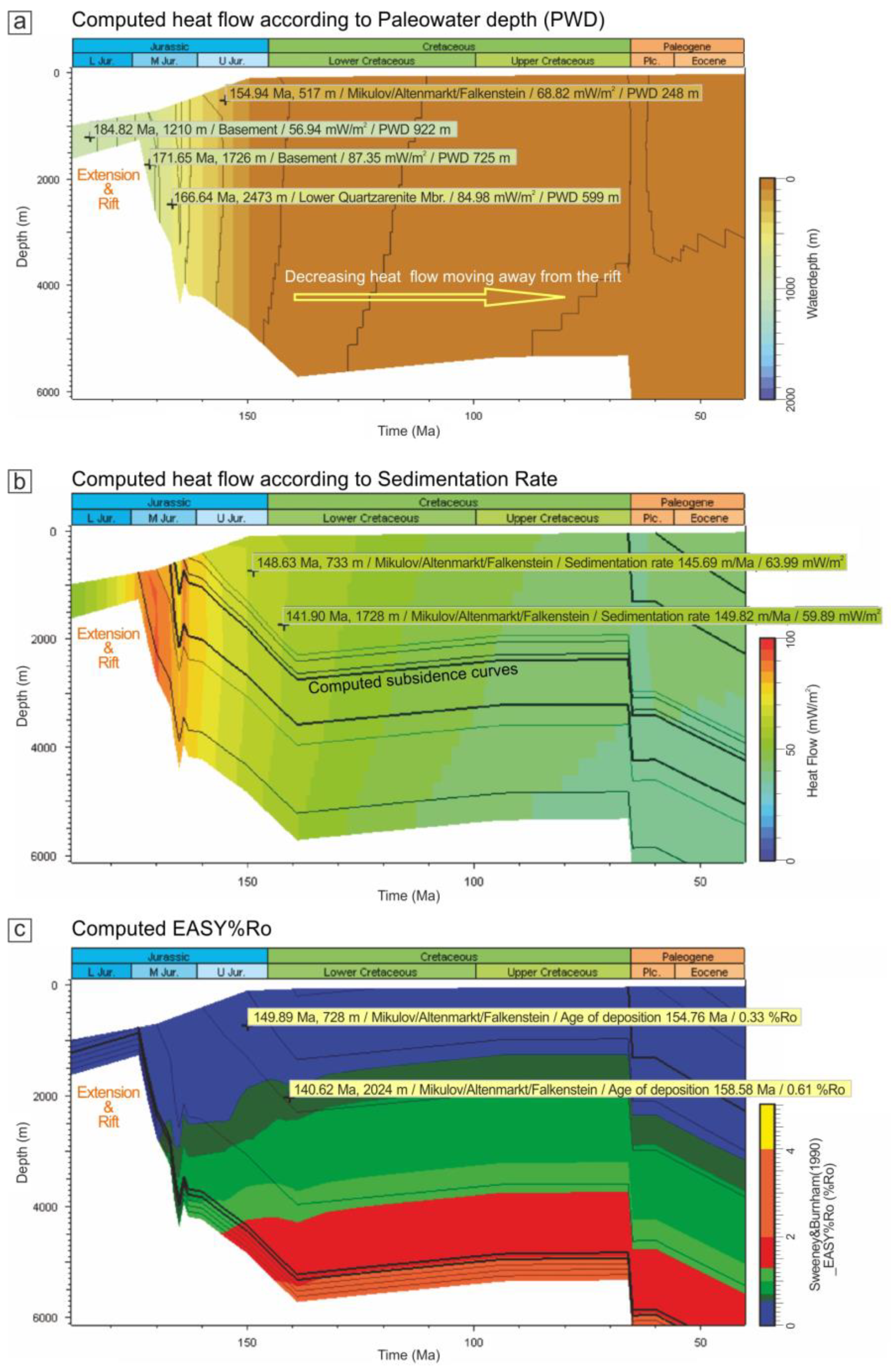

Disclaimer/Publisher’s Note: The statements, opinions and data contained in all publications are solely those of the individual author(s) and contributor(s) and not of MDPI and/or the editor(s). MDPI and/or the editor(s) disclaim responsibility for any injury to people or property resulting from any ideas, methods, instructions or products referred to in the content. |
© 2024 by the authors. Licensee MDPI, Basel, Switzerland. This article is an open access article distributed under the terms and conditions of the Creative Commons Attribution (CC BY) license (https://creativecommons.org/licenses/by/4.0/).
Share and Cite
Spahić, D.; Lee, E.Y.; Šajnović, A.; Stepić, R. Opening and Post-Rift Evolution of Alpine Tethys Passive Margins: Insights from 1D Numerical Modeling of the Jurassic Mikulov Formation in the Vienna Basin Region, Austria. Geosciences 2024, 14, 202. https://doi.org/10.3390/geosciences14080202
Spahić D, Lee EY, Šajnović A, Stepić R. Opening and Post-Rift Evolution of Alpine Tethys Passive Margins: Insights from 1D Numerical Modeling of the Jurassic Mikulov Formation in the Vienna Basin Region, Austria. Geosciences. 2024; 14(8):202. https://doi.org/10.3390/geosciences14080202
Chicago/Turabian StyleSpahić, Darko, Eun Young Lee, Aleksandra Šajnović, and Rastimir Stepić. 2024. "Opening and Post-Rift Evolution of Alpine Tethys Passive Margins: Insights from 1D Numerical Modeling of the Jurassic Mikulov Formation in the Vienna Basin Region, Austria" Geosciences 14, no. 8: 202. https://doi.org/10.3390/geosciences14080202
APA StyleSpahić, D., Lee, E. Y., Šajnović, A., & Stepić, R. (2024). Opening and Post-Rift Evolution of Alpine Tethys Passive Margins: Insights from 1D Numerical Modeling of the Jurassic Mikulov Formation in the Vienna Basin Region, Austria. Geosciences, 14(8), 202. https://doi.org/10.3390/geosciences14080202









